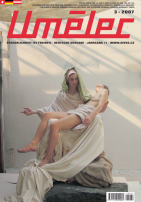|
In the Fifties, Andy Warhol’s technique of massive silkscreen reproductions brought on the collapse of the Avant Garde’s search for an object or theme that would be a subject of artistic interpretation in any and all areas. For Warhol, art did not effect or imitate life; life was an art in itself, a view which bestowed importance on moments and reshaped the experience of everyday life in its entirety. Living in Mexico City, it is inevitable that I think of Warhol every morning, as I find the front pages of newspapers practically slippery with blood, showing an execution or decapitation, or perhaps, as in yesterday’s paper, photographs of a child beaten to death and bitten by his adolescent mother. Violence in art is not a theme that little has been written about; however, as theorists say, it has always been explored from the “obsolete” paradigm of aesthetics. These graphic photos taken by the journalists of this city—do they possess any aesthetic value? And if not, why not? How is it that around the world there are exhibitions of illustrations, paintings and video pieces that portray violence through artifice, yet it is neither artistically, nor politically correct to have an exhibition that celebrates, say, the decades of news photography in “La Prensa,” a model of yellow journalism? In the last few years, this country has undertaken a superfluous search for that which defines our identity. Indeed, we have adopted fashions that try to replicate "indigenous and folk" customs and traditions, but do so by stripping them of their meaning and through recontextualizing them in pricey textile designs or commercialized industries. We try to realize the creation of a market for original national products, all the while exalting our name in stock markets for creating jobs in different and distant communities. All this notwithstanding, it is worthwhile to examine the authenticity of this cultural richness; is this apparent peace and harmony between diverse towns enough to define a country? Would not the violence, corruption and terrible crimes committed by members of government and society be a more truthful identification card? Would it not be more useful to present our own reality as it is, rather than turn to other more cosmopolitan latitudes to disguise ourselves in international style, leaving us laundered of all our natural crudity? The first option could result in an exercise of reflection, possibly with the participation of all citizens, through which we could confront ourselves, from the worst part of our identity, the worst of our reality. Sadly, the benefits that this could bring to artists and galleries cannot be seen, and we continue to delight ourselves in our caramelized society and cultural production— its internationality and its convenient ambiguity.

Рекомендуемые статьи

|
|
"In Cameroon, rumours abound of zombie-labourers toiling on invisible plantations in an obscure night-time economy."
|

|
|
Goff & Rosenthal gallery, Berlin, November 18 - December 30, 2006
Society permanently renegotiates the definition of drugs and our relationship towards them. In his forty-five minute found-footage film The Conquest of Happiness, produced in 2005, Oliver Pietsch, a Berlin-based video artist, demonstrates which drugs society can accommodate, which it cannot, and how the story of the drugs can be…
|

|
|
“A person must shake someone’s hand three times while gazing intently into their eyes. That’s the key to memorizing their name with certainty. It is in this way that I’ve remembered the names of 5,000 people who have been to the Horse Hospital,” Jim Hollands told me. Hollands is an experimental filmmaker, musician and curator. In his childhood, he suffered through tough social situations and…
|

|
|
The editors of Umělec have decided to come up with a list of ten artists who, in our opinion, were of crucial importance for the Czech art scene in the 1990s. After long debate and the setting of criteria, we arrived at a list of names we consider significant for the local context, for the presentation of Czech art outside the country and especially for the future of art. Our criteria did not…
|
|







Комментарии
Статья не была прокомментированаДобавить новый комментарий